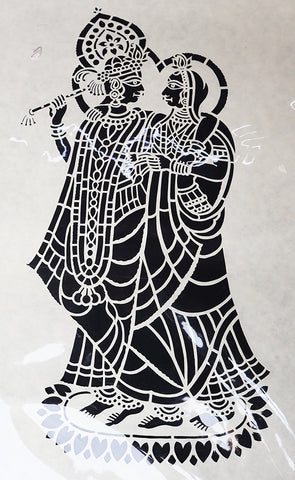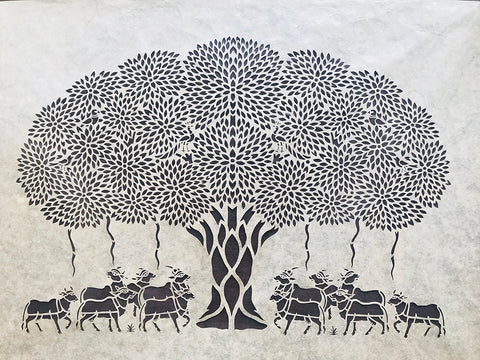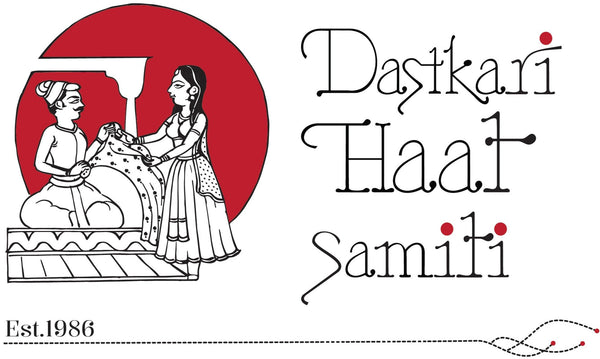Sanjhi: The Art of the Dusk
As his scissors swiftly glided over the paper, the onlookers held their breath, anticipating the unveiling of a masterpiece. As the delicate outline of hands cradling a flute emerged on the paper, it became evident: Lord Krishna was taking shape before their eyes. Unspoken queries filled the air. Pausing for a brief minute to examine the crowd accumulated in his stall, Ashutosh Verma gives his fingers rest. As if the visitors took the cue to hurl a barrage of questions at him- Could you tell us about the craft, What are the themes you incorporate in your work, where is it practiced? How do the designs maintain such precision?
To see one’s art being revered and eyed with such enthusiasm and curiosity brings great joy to artists. Hence began Ashutosh narrating tales of a craft that serves as a conduit of expression for artists’ devotion to Krishna:

Ashutosh Verma at his exhibition stall
Sanjhi, as the name suggests, derives its collective meaning from the terms ‘sajja’, sajawat, ‘shringar’, and ‘saanjh’, implying- a decorative art depicting beauty, revered and worshiped at dusk. As a sixth-generation artist carrying on my family's 300-year tradition, I have witnessed Sanjhi evolve while maintaining its core. The stories of Radha Krishna permeate people's homes and hearts in the mystical city of Mathura-Vrindavan. For some, this is achieved through hymns, while for others, it is through the art of Sanjhi.
Since childhood, we’ve heard stories of Lord Krishna and his beloved consort Radha. It is believed that to make Krishna happy, Radha used to make Sanjhi in the evening, upon which feeling elated, Krishna would acknowledge the beauty of the art by playing melodies on his flute, admiring it before heading home. In the heart of Mathura, Krishna’s hometown, as the evening sets in and the melodic strains of soul-stirring aarti fills the air, hymns intertwine with reverence, and offerings are tenderly bestowed upon the Sanjhi.

Radha-Krishna, a revered theme of Sanjhi art
In the quaint streets of Braj, where devotion to our lord thrives year-round, the arrival of the annual Pitru Paksha event, spanning a reverent 15-16 days, marks a special occasion. During this time, the community gathers to partake in the traditional Sanjhi ritual, meticulously crafting intricate designs using finely powdered rice flour known as "khaakh." Using ‘Saanch’ or a mold, patterns, and designs are created by sprinkling rice flour or other colored powders onto a surface.
Across diverse regions, the art of Sanjhi takes on unique forms, reflecting the cultural nuances and artistic preferences of each locality. Picture Mathura-Vrindavan, where whispers of ancient love stories mingle with the fragrance of fresh earth. Here, amidst the labyrinthine streets, unmarried women become artisans of fate, adorning walls with "Khadi Sanjhi" using a blend of gobar (cow dung) and mitti (mud). It symbolizes their hopes for a prosperous marital future, each stroke a silent prayer for a future enriched with love and prosperity. As one goes beyond these hallowed streets, "Khadi Sanjhi" morphs into a kaleidoscope of colors and textures- it incorporates a medley of materials such as phool, gobar, and mitti, resulting in vibrant and varied expressions of this ancient craft.
Yet, there's more to this narrative tapestry. Journey deeper into the folds of tradition, and you'll stumble upon the lying form of Sanjhi, where Khaakh and Saanch are used to create its visually captivating forms with geometric precision. Usually, we work on a scale of a foot to one-and-half feet, making it easier for us to make intricate cuts. Back when the art was on the brink of extinction, it was reborn in the form of Jal Sanjhi, in which dry colors are sifted onto the water's surface. Drawing ancient roots, its precursor is Hasthmukt Sanjhi. Artisans would meticulously create designs on the floor or specially made platforms using materials like gobar mitti, resembling yagya rituals. Traditionally what began as carving using knives and nails on ‘Bhyi k Kagaz’ (paper made from the bark of banyan tree and Bhoj patra (birch bark), transitioned to the usage of scissors-initiated by my Baba. This tradition passed down through generations.
But now Sanjhi has evolved. It has seen a shift from traditional khaak styles to contemporary paper-cutting methods, reflecting our adaptability to changing times.

Installation 'Prakriti' at Shilp Gallery, New Parliament
Unlike its association primarily with religious festivities like Pitru Paksha, Sanjhi art now engages our artisan community throughout the year. As time progressed, it gave rise to new renditions such as trays, lamps, and coasters -even finding a place in contemporary decor- as partitions and decorative pieces. By Lalla’s grace, we’ve had the opportunity to craft Sanjhi as decor for various esteemed institutes and enterprises. My work in Shilp Deergha Gallery at the New Parliament is a proud feather to my hat. Displayed at the installation section named ‘Prakriti, my work commemorated nature and its nourishing prowess. Filigree of vines and leaves, motifs of birds, peacocks and a procession of villagers could be seen. The motivation was to celebrate nature and retrace the universal roots of devotion.

Tree of Life and Krishna's cows
What remains shrouded in mystery is its precise origins- ongoing research suggests that no single individual can be credited with its inception. Instead, we perceive the art form as a hereditary trait, deeply ingrained within families and passed down through generations. For us, it's a spiritual practice that transcends mere craftsmanship. Contrary to misconceptions, Sanjhi art is not merely stencil-based nor a Rangoli, but requires meticulous precision and skill. One might think- what if the paper tears and the design gets ruined? Well, incessant practice over the last fifteen years doesn’t let the hands do so!

Maharaas Leela
Despite innovations, Sanjhi’s essence remains rooted in devotion and worship, primarily depicting scenes from Hindu mythology, particularly those related to Lord Krishna, Radha, and Maharaas Leela. Besides traditional themes, we make diverse designs catering to different market needs. Say the theme is nature, hence we craft an intricate Tree of Life. In Vrindavan, we have temples like Radha Raman Mandir, Radha Bhallav, Patti Ji ki Haveli, and others that uphold the Sanjhi tradition. Why is it so significant - since it emphasizes spiritual significance over commercial interests. We respect that notion a lot. The more you practice the craft, the more immersed you become- such is its essence.
I believe for a legacy to endure, community support plays an important role. We have our own Gurukul where any individual keen on learning is provided with free education on the art form. Presently we have more than 50 students. We aspire that the number flourishes, and so does the reverence for this art form in the eyes of every beholder.

